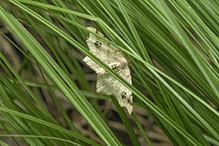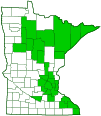common angle
(Macaria aemulataria)
Conservation • Description • Habitat • Ecology • Distribution • Taxonomy
|
||||||||
| Hodges # | 6326 |
|||||||
Conservation Status |
||||||||
| IUCN Red List | not listed |
|||||||
| NatureServe | NNR - Unranked SNR - Unranked |
|||||||
| Minnesota | not listed |
|||||||
Description |
||
Common angle is a common, small, typical geometer moth. It occurs across the United States and southern Canada, in Mexico, in Central America, and in South America. It is most common in the U.S. east of the Great Plains. It is common in eastern and north-central Minnesota. The larvae feed on the leaves of maple and boxelder, and possibly of hackberry, and honey locust, and other trees. Adults are found from May through June, and probably into August, in woodlands and forested areas with maples. Adults are ⅜″ (10 mm) in length and have a ¾″ to 1″ (20 to 25 mm) wingspan. The forewing length of females is 7⁄16″ to 9⁄16″ (11 to 14 mm), of males is ⅜″ to ½″ (10 to 13 mm). The forewing is broad and strongly angulate. The outer margin has a shallow, cycle-shaped indentation near the tip. The indentation is accented with a dark fringe. The ground color of the wing is off-white to cream-colored or very pale brown. It is usually densely peppered with grayish-brown to yellowish-brown scales, making the wing appear darker. The antemedial (AM), median, and postmedial (PM) bands are narrow, slightly wavy, and almost parallel. They are distinct but not bold. Each band is darkened and strongly angled forward near the leading edge (costal margin). On the PM band there is usually a small dark brown spot where it crosses each vein. The terminal line is thin, dark, and usually broken into a series of dashes. There is a large, roundish, dark, “paw print” spot near the middle of the wing straddling the PM band. It is dissected by the pale PM band and two pale wing veins into five distinct sections. There is a smaller, squarish spot in the postmedial area at the costal margin. The hindwing is strongly angled at the outer margin with a pointed extension that gives it a tailed look. The AM band is absent. The median band is nearly straight. The PM band is strongly wavy, convex, and sometimes broken. The terminal line is similar to that on the forewing. There is a small dark discal spot. The hindwing is otherwise unmarked. The head and thorax are the same color as the forewings. The antennae on the female are thread-like. The antennae on the male are moderately saw-toothed (serrate), not branched (pectinate). On the front legs, the fourth segment (tibia) does not have a spine at the tip. On the hind legs, the tibia is not swollen. |
||
Size |
||
Total length: ⅜″ (10 mm) Wingspan: ¾″ to 1″ (20 to 25 mm) Female forewing length: 7⁄16″ to 9⁄16″ (11 to 14 mm) Male forewing length: ⅜″ to ½″ (10 to 13 mm) |
||
Similar Species |
||
Habitat |
||
Woodlands and forested areas with maple |
||
Ecology |
||
Season |
||
One generation per year: May through June |
||
Behavior |
||
Adults are active at night and will come to lights. The wings are held flat and spread out when at rest. |
||
Life Cycle |
||
|
||
Larva Hosts |
||
Leaves of maple and boxelder |
||
Adult Food |
||
|
||
Distribution |
||||
|
Sources |
|||
| 7/18/2023 | ||||
Occurrence |
||||
Common |
||||
Taxonomy |
|||
Order |
Lepidoptera (Butterflies and Moths) | ||
Superfamily |
Geometroidea (Geometrid and Swallowtail Moths) | ||
Family |
Geometridae (Geometer Moths) | ||
Subfamily |
Ennominae (Typical Geometers) | ||
Tribe |
Macariini (angle moths and allies) | ||
Genus |
Macaria | ||
Synonyms |
|||
Macaria aspirata Macaria sectomaculata Philobia perplexata Philobia versitata Philobia aspirata Semiothisa perplexata Semiothisa aspirata Semiothisa versitata Semiothisa aemulataria |
|||
Common Names |
|||
common angle common angle moth |
|||
Glossary
Costal margin
The leading edge of the forewing of insects.
Tibia
The fourth segment of an insect leg, after the femur and before the tarsus (foot). The fifth segment of a spider leg or palp. Plural: tibiae.
Visitor Photos |
|||||
Share your photo of this insect. |
|||||
| This button not working for you? Simply email us at info@MinnesotaSeasons.com. Attach one or more photos and, if you like, a caption. |
|||||
Greg Watson |
|||||
 |
|||||
MinnesotaSeasons.com Photos |
|||||
|
|||||

Slideshows |
||
| Common Angle - Hodges#6326 (Macaria aemulataria Andree Reno Sanborn |
||
 |
||
| Macaria aemulataria rene odeide |
||
 |
||
About
Macaria aemulataria |
||

Visitor Videos |
|||
Share your video of this insect. |
|||
| This button not working for you? Simply email us at info@MinnesotaSeasons.com. Attach a video, a YouTube link, or a cloud storage link. |
|||
Other Videos |
|||
| Common Angle Moth (Geometridae: Macaria aemulataria) on Grass Carl Barrentine |
|||
About
Jul 24, 2011 Photographed at Fisher, Minnesota (24 July 2011). |
|||
| Common Angle Moth (Geometridae: Macaria aemulataria) Dorsal view Carl Barrentine |
|||
About
Aug 16, 2011 Photographed at the Turtle River State Park, North Dakota (16 August 2011). |
|||
| Common Angle Moth (Macaria aemulataria) Alevilla Angulada videotecaFaunaPR |
|||
About
Oct 14, 2022 DESCRIPCIÓN: Este lepidóptero pertenece a la familia Geometridae. Se encuentra en América, desde Canadá hasta Uruguay, incluyendo República Dominicana y Puerto Rico. Tiene muchas variantes fenotípicas. En general, las alas proyectan bordes irregulares y una envergadura de ~2 cm. La parte dorsal es crema con líneas onduladas paralelas y oscuras y dos puntos pardos sobresalientes; la parte inferior es más amarillenta. Las alas traseras forman un ángulo recto, de ahí su nombre popular. Tanto el tórax como el abdomen exhiben de seis a ocho puntos oscuros. Son muy tolerantes a la presencia humana. Filmado en Orocovis. Google Translate: DESCRIPTION: This lepidoptera belongs to the Geometridae family. It is found in America, from Canada to Uruguay, including the Dominican Republic and Puerto Rico. It has many phenotypic variants. In general, the wings project jagged edges and a wingspan of ~2 cm. The back is cream with dark parallel wavy lines and two prominent brown spots; the underside is more yellowish. The hind wings form a right angle, hence its popular name. Both the thorax and the abdomen display six to eight dark spots. They are very tolerant of human presence. Filmed in Orocovis. |
|||
| Common Angle Moth Tiny Turtle Projects |
|||
About
Mar 29, 2022 Macaria aemulataria |
|||

Created: 7/18/2023
Last Updated:


